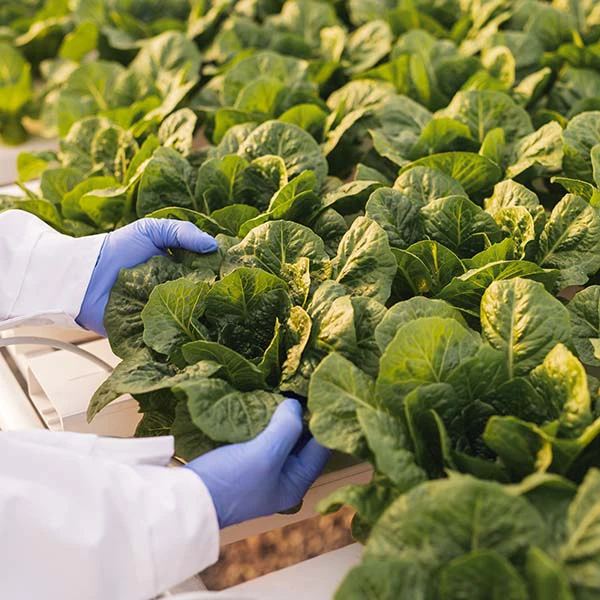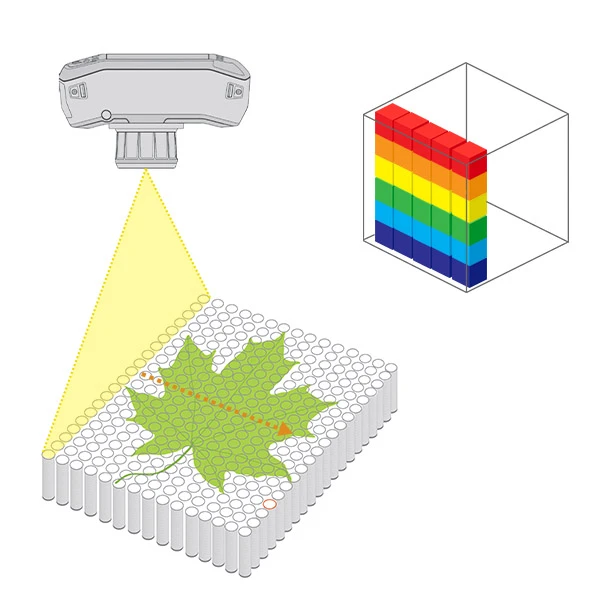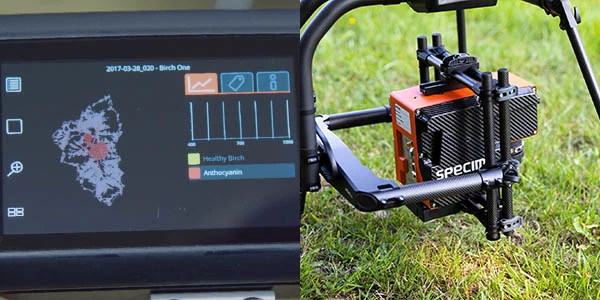Plant Phenotyping Using Hyperspectral Imaging

Plant phenotyping entails the study of plant structure and function, including growth, yield, biotic and abiotic stress response, and quality. Traditional methods for phenotyping are time-consuming, laborious, and destructive. This necessitates the need for high throughput rapid and non-destructive technologies.
Hyperspectral imaging (HSI) provides rapid spectral and spatial information from a broad range of the electromagnetic spectrum non-invasively, demonstrating its usefulness in studying plants’ structural and functional traits. Asaari et al. (2018) utilize HSI to detect drought stress in maize plants, while Wahabzada et al. (2015) use HSI to study and analyze the foliar pathogen in barley leaves. Kim et al. (2011) use HSI to identify and analyze the onset and intensity of water stress in apple trees.
The needs of HSI may differ based on the plants’ traits that needs to be measured or analyzed. It’s important to understand how light interact with plants and have some basic understanding about HSI’s technologies, illumination, and data processing workflow before setting up an effective data acquisition and processing platform for your plant phenotyping.
Light and Plants Interaction – Spectral Wavelength
The physical, chemical, and biological characteristics of leaves affect how light is reflected, absorbed, or transmitted. Understanding these interactions is essential in selecting the right hyperspectral camera and spectral wavelength for your intended application. For plant phenotyping, the most useful wavelength ranges to analyze are the visible light (VIS) region (400–700 nm), near-infrared (NIR) region (700–1,000 nm), and the short-wave infrared (SWIR) region (1,000–2,500 nm). For example, the VIS region provides information on the leaf pigmentation like chlorophyll or carotenoids, whereas the NIR region can be used to analyze changes in the plant cell structure. The red edge, which is a narrow section between the VIS and NIR regions, is commonly used to detect plant stress. The SWIR region can be used to obtain information about the water and protein content of the plant.

Hyperspectral Imaging Technology
A hyperspectral camera is an integration of spectroscopy and digital imaging technologies. The collected data set, commonly known as a hypercube or data cube, includes hundreds of images of contiguous and narrow spectral wavelength (bands), providing an object’s 2D distribution of its spectral signatures. There are many different kinds of hyperspectral cameras and can be classified by how they obtain the hypercube. Pushbroom (line-scan) hyperspectral cameras are commonly used in remote or close-range sensing and play a dominant role in plant phenotyping. These hyperspectral cameras capture one line of pixels each time and acquire hypercube by scanning a single line across the object.
Hyperspectral Imaging Illumination
Lighting is one of the most significant aspects to consider in HSI when it comes to obtaining a high-quality hypercube. An ideal illumination system should provide totally diffused light to ensure that objects are uniformly illuminated. Furthermore, the light source should be able to illuminate objects over the entire desired spectral wavelength while maintaining uniformity. For example, halogen lighting is commonly used in indoor HSI applications as they emit light in the VIS, NIR, and SWIR range without sharp spectral peaks.
Hyperspectral Imaging Data Processing
Once the hypercube is acquired, it will need to go through processing, which typically includes pre-processing and segmentation. Data pre-processing, like the standard normal variate (SNV) method, smoothing filtering method, etc., aims to improve image contrast and eliminate noise. Image segmentation is applied to extract the region of interest, e.g., segment the green plants from the irrelevant background. Feature vectors are extracted from the spectral signatures using methods like fourier features extraction, wavelet feature extraction, principal components transform, etc.
Specim Hyperspectral Cameras
Specim, a leading HSI solution provider, offers various pushbroom hyperspectral cameras that cover wavelengths ranging from VIS to long wavelength infrared (LWIR). From portable hyperspectral camera Specim IQ that is suitable for laboratory and field/on-site usage to airborne and remote sensing hyperspectral systems, plant phenotyping with HSI is made simple with Specim.

Plant phenotyping with Specim IQ (left) and Specim AFX series (right). Image courtesy of SPECIM, SPECTRAL IMAGING LTD.
Interested to find out more about HSI or require assistance in setting up an HSI system for your plant research and studies? Get in touch with our specialist for a free consultation now.
